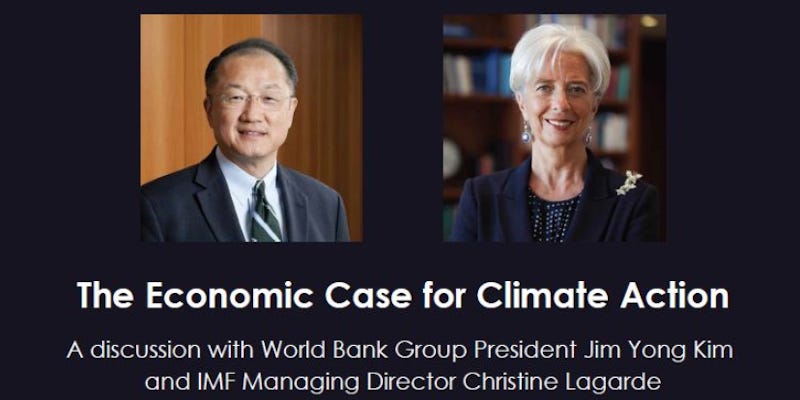Climate change at the World Bank: “You can imagine a future world where carbon is really the currency of the 21st century”
Earlier this week, Jim Yong Kim, the president of the World Bank and Christine Lagarde, the managing director of the International Monetary Fund spoke about climate change. This was the first time that the two have spoken together in public about climate change.
They talked for about 20 minutes, under the moderation of Zanny Minton Beddoes, Economics Editor at The Economist and a panel discussion followed. You can watch the discussion on the World Bank’s website: “The Economic Case for Climate Action”.
Kim and Lagarde seemed confident that they are on top of the situation. Lagarde made two proposals to address climate change:
“If there are two things that you remember from what I am saying now, that’s it. Getting the pricing right and remove the energy subsidies that amount to approximately US$485 billion today.”
Energy subsidies are certainly something that the World Bank should be looking at. Last year, according to an analysis by Oil Change International, the World Bank increased its lending for fossil fuels. Of course, neither Lagarde nor Kim mentioned the World Bank’s lending for fossil fuels. Unfortunately, the moderator was too polite to mention the US$2.7 billion that the Bank poured into oil, gas and coal projects last year.
Also off the agenda was the necessity of keeping fossil fuels in the ground. No one raised the issue of the carbon budget – the amount of greenhouse gases in the atmosphere and how much more can be emitted, if we are to keep warming to below 2°C. The only way of staying within the carbon budget is to leave fossil fuels in the ground.
“Getting the pricing right” involves carbon markets, as Jim Yong Kim made clear:
“Given what they [the IMF] are focussing on, which is clear, we work on carbon markets too, but I think the IMF’s role could be huge, carbon markets and fuel subsidies, and us focussing on energy, cities and agriculture, I think we can honestly say now to the world, that we have a robust solution right now to tackling this issue.”
Really? More than 15 years of carbon trading has failed to reduce greenhouse gas emissions. The price of carbon has crashed. Nevertheless, Kim talked about “encouraging signs”:
“On the stable price of carbon, we’re seeing some encouraging signs, China is launching a pretty major carbon trading scheme. And if you get China, Europe and the United States to begin having conversations and really showing leadership in this area, if you get those three, China, Europe and US, moving in the right direction, I think we’re very close to some kind of an agreement, certainly to progress.”
Memo to World Bank President: The price of carbon is stable. It’s also very low. Oh, and carbon trading doesn’t reduce emissions.
Later on in the panel discussion, after the heads of the World Bank and IMF had left, Michael Keen, Deputy Director of the Fiscal Affairs Department of the IMF, explained that the price of carbon should be US$25:
“If we get real in terms of the kind of numbers we’re talking about if we think about a carbon charge of something like US$25 per ton of carbon dioxide, that’s about 1% of GDP in the US, 2% of GDP in China. So it’s serious money.”
This elicited a rare challenge from Beddoes, the moderator. “We’re a long way from that,” she noted. (The current price of EU Emission Allowances is about US$6.20, or about 25% of Keen’s suggested price. Meanwhile carbon credits [CERs] can be bought for US$0.76. And the reality is that a carbon price of US$25 is still way too low.) Keen repeated Beddoes’ point, but didn’t seem to understand the significance of it.
“We’re a long way from that. It’s a serious amount of money. It doesn’t solve all the problems, but the potential is clearly there and people are becoming more aware of it, I think.”
Rachel Kyte, the World Bank’s Vice President for Sustainable Development, was also on the panel. She talked about “new platforms for crowding in private finance”, an “ability to leverage large amounts of private finance”, “risk-reward profiles”, “speed and scale”, and “innovation”. Her only concrete suggestion about reducing greenhouse gas emissions was “renewable street lighting in cities around the world”. But when she got on to the topic of carbon markets she completely let go of any sense of reality:
“So, we’ll push for all of the innovation that we can, but I think we want to work together with the Fund not just on the case for carbon taxes, but also for those countries that are pursuing market based mechanisms, to show that you can imagine a future world where carbon is really the currency of the 21st century and that we can manage carbon as a currency and start thinking about carbon as a tradable asset, not in the way that we think about it now with the European price so low and everybody spooked, but really imagine that this is a currency that has to be managed and there is creativity around that.”
Last week, the World Bank’s Forest Carbon Partnership Facility selected a new coordinator, Ellysar Baroudy. Her previous job was in charge of the BioCarbon Fund, a public-private initiative within the Bank’s Carbon Finance Unit, aimed at “paving way for the growing land-use carbon market”.



